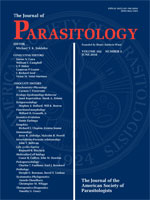The symbiotic relationship of Wolbachia spp. was first observed in insects and subsequently in many parasitic filarial nematodes. This bacterium is believed to provide metabolic and developmental assistance to filarial parasitic nematodes, although the exact nature of this relationship remains to be fully elucidated. While Wolbachia is present in most filarial nematodes in the family Onchocercidae, it is absent in several disparate species such as the human parasite Loa loa. All tested members of the genus Acanthocheilonema, such as Acanthocheilonema viteae, have been shown to lack Wolbachia. Consistent with this, we show that Wolbachia is absent from the seal heartworm (Acanthocheilonema spirocauda), but lateral gene transfer (LGT) of DNA sequences between Wolbachia and A. spirocauda has occurred, indicating a past evolutionary association. Seal heartworm is an important pathogen of phocid seals and understanding its basic biology is essential for conservation of the host. The findings presented here may allow for the development of future treatments or diagnostics for the disease and also aid in clarification of the complicated nematode–Wolbachia relationship.
How to translate text using browser tools
1 June 2016
Absence of the Filarial Endosymbiont Wolbachia in Seal Heartworm (Acanthocheilonema spirocauda) but Evidence of Ancient Lateral Gene Transfer
Caroline D. Keroack,
Jenna I. Wurster,
Caroline G. Decker,
Kalani M. Williams,
Barton E. Slatko,
Jeremy M. Foster,
Steven A. Williams
ACCESS THE FULL ARTICLE

Journal of Parasitology
Vol. 102 • No. 3
June 2016
Vol. 102 • No. 3
June 2016




